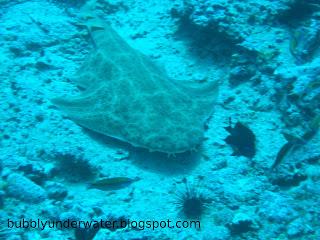
p { margin-bottom: 0.21cm; }
Spotting a Mediterranean angel shark was, for me, a case of seeing something spectacular and not even realizing it. It was only later that I found out that the thing is actually quite rare, critically endangered in fact. And I thought it was just kind-of-a-shark! Well, the latin name of the species, squatina, does actually mean "a kind of shark", so I guess I was half right.
To be honest I wasn’t all that excited about it when I spotted it. I had been hoping to see sharks on the dive, but didn’t really consider it quite the same thing. Don’t get me wrong, it was great to see it lying on the bottom, and I got some pictures of it, too.
The angel shark, sometimes also called monk fish or sand devil, is a bottom-dwelling shark. It gets its distinctive appearance from having unusually large pectoral fins (kind of like an angel’s wings, I guess). The flat shape of its body and large fins make it look more like a ray than a typical shark. Angel sharks are not as aerodynamic as some other sharks, and are not very fast swimmers.
I spotted the angel shark on a dive near Tenerife, in the Canary Islands. At the time it seemed very harmless, lazing on the bottom like it was. Apparently, though, angel sharks can bite quite seriously if disturbed. In fact, the odds are it wasn’t lazing at all, but lying in ambush just waiting to make a surprise attack on its pray (not me, obviously, but some little fish that I probably managed to frighten away, splashing around like I did. Sorry!) Angel sharks used to range the coasts of Europe from Norway in the North all the way to the Mediterranean and Northern Africa in the South. Populations declined dramatically during the 20th century, mostly due to industrial fishing. It is now considered extinct in the North Sea, and endangered and extremely uncommon in most other areas, with the possible exception of some areas of the southern Mediterranean and, indeed, Canary Islands, where I spotted mine.